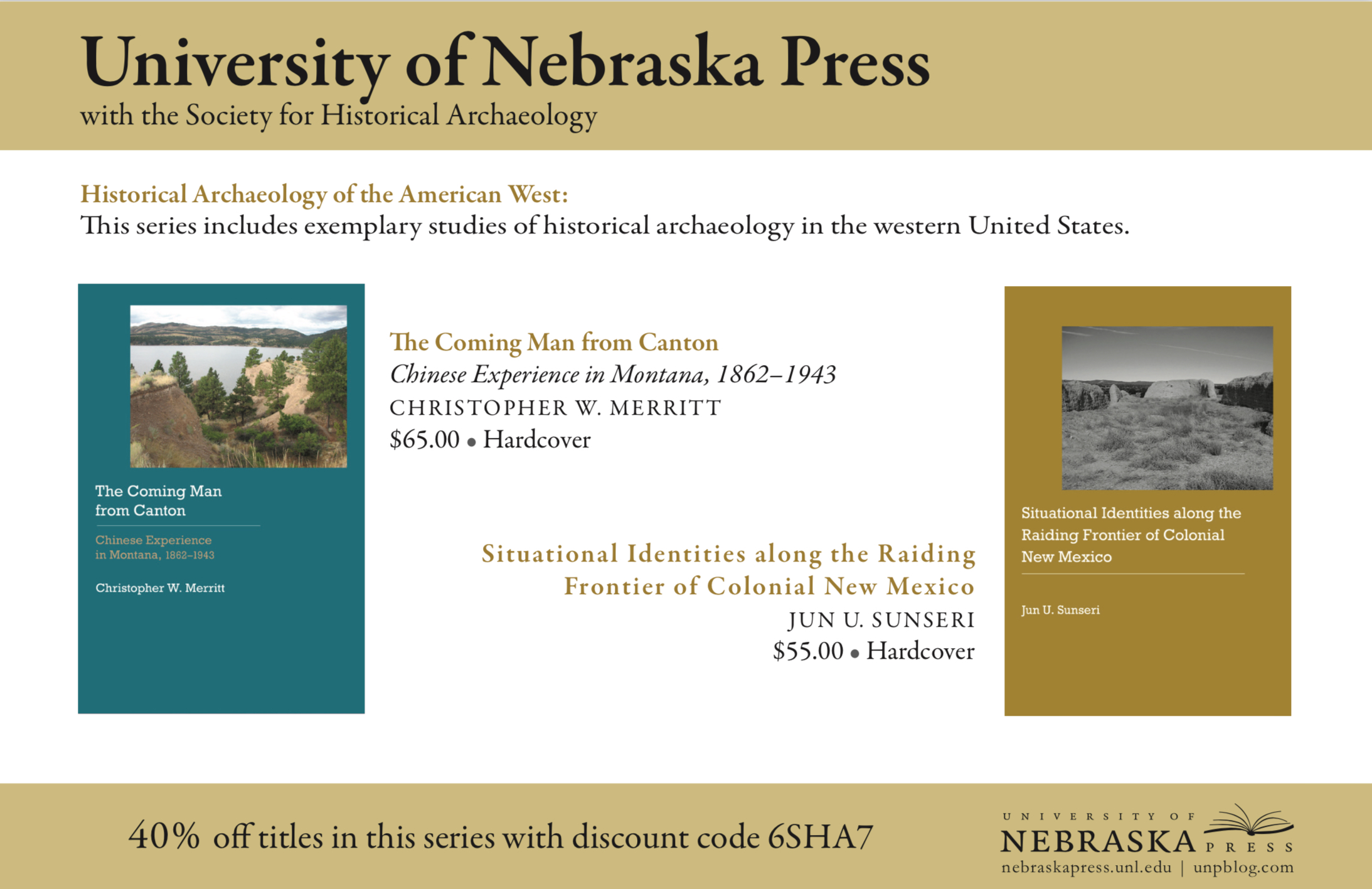Regional Introductions in Historical Archaeology
Readers of Historical Archaeology have certainly noticed the two shorter articles that open up the…
Submitted by Rebecca Allen
Environmental Science Associates (ESA), Cultural Resources Director
SHA Associate Editor
In 2011, the University of Nebraska Press and the SHA jointly published the first of the Historical
Archaeology of the American West Series. Annalies Corbin and I are series editors, and over the course
of this year, we will be contributing to the SHA blog to highlight authors in this series. The primary goal
of SHA’s co-publication program is to expand our membership’s publication opportunities, and find
more partners to promote our field. UNP publishes many titles in American Studies, Anthropology,
History, and Native American and Indigenous studies. The press regularly exhibits at western regional
and national history conferences, bringing the topic of historical archaeology to a wider audience.
Take advantage of the discount to order your copies of new volumes by Jun Sunseri and Chris Merritt.
On behalf of the SHA, I’d like to thank these authors, as all royalties in this series return to SHA
publications, to fund future studies. And please contact me (rallen@esassoc.com) if you are interested
in contributing a volume in this series.
ABOUT THE BOOK
Situational Identities along the Raiding Frontier of Colonial New Mexico
Jun U. Sunseri
240 pages
3 photographs, 39 graphs, 5 maps, 16 illustrations, 4 tables, index
Situational Identities along the Raiding Frontier of Colonial New Mexico examines pluralistic communities that navigated between colonial and indigenous practices to negotiate strategic alliances
with both sides of generations-old conflicts. The rich history of the southwestern community of Casitas
Viejas straddles multiple cultures and identities and is representative of multiple settlements in the
region of northern New Mexico that served as a “buffer,” protecting the larger towns of New Spain from
Apache, Navajo, Ute, and Comanche raiders. These genízaro settlements of Indo-Hispano settlers used
shrewd cross-cultural skills to survive.
Researching the dynamics of these communities has long been difficult, due in large part to the lack of
material records. In this innovative case study, Jun U. Sunseri examines persistent cultural practices
among families who lived at Casitas Viejas and explores the complex identities of the region’s
communities. Applying theoretical and methodological approaches, Sunseri adds oral histories,
performative traditions of contemporary inhabitants, culinary practices, and local culture to traditional
archaeology to shed light on the historical identities of these communities that bridged two worlds.
AUTHOR INTERVIEW
RA: What are some of your motivations for writing this book?
JS: Discussions with my colleagues, the SHA co-publication editors, and editors at UNP reminded me that
this story that I first addressed in my dissertation was truly worth re-working and re-telling, and they
helped me bring it alive. In more ways than I can count, the opportunity to work closely with the
descendant community and a rich network of scholars on this project was rewarding and truly affirming of why I left engineering for archaeology. I am hoping to share some of that energy and the nuances of
the story with a wider audience.
RA: Who would you like to read this book? Who is your audience?
JS: First and foremost, this book is dedicated to the descendant community and the places and people
who guided, protected, and sacrificed to bring the work to fruition. It is incredibly gratifying to hear that
advance copies are already being read enthusiastically and handed from person to person there. I am
also hoping that communities who are also struggling with land and water rights, for whom archaeology
has not always been a service or a resource, might be inspired to connect and build coalitions with each
other.
RA: Now that you have published this book, what kinds of things are you dreaming up next? What is in
the works?
JS: I’ve already been asked to present with community partners about this book this fall in New Mexico
and we are looking forward to building momentum on a number of issues related to this work. Other
villages in New Mexico have asked for partnerships related to these kinds of complex cultural
patrimonies. I might change gears for a little while and concentrate on method and theory a little more,
specifically issues of labor and scales of economy related to butchery and other human-animal
interactions.
